
Miso ramen is a warm, savory noodle soup that is most popular in Northern Japan but can be found in most ramen shops around the world. Known for its rich umami flavor, miso ramen is one of the most popular ramen dishes and is a must try for anyone new to ramen.
While some types of ramen broth can take days to prepare, our authentic miso ramen can be prepared in around 35 minutes. Below we have a recipe and video that will show you how to prepare this savory dish step-by-step.
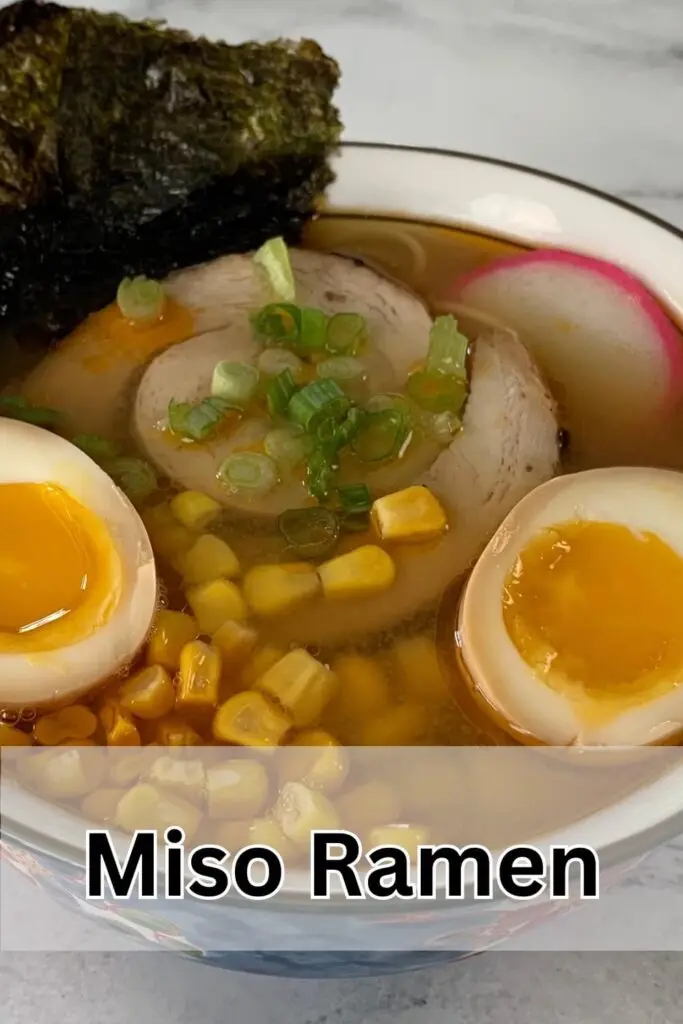
Table of Contents
What is Miso Ramen?
Widely regarded as a Japanese dish, ramen originated in China and was first introduced to Japan in the late 1800’s to early 1900’s as a quick and inexpensive street food. Over the course of the century it spread throughout the country with each region adding their own unique twists based on local ingredients popular in that region.
Today, ramen can be enjoyed in ramen shops all over Japan and around the world. There our four main varieties that can be found in most ramen restaurants in addition to several regional varieties. The four main types of ramen are shio ramen, shoyu ramen, miso ramen, and tonktotsu ramen.
Miso ramen originated in Hokkaido, in Northern Japan. It’s known as a more hearty style of ramen and is often served with ground pork and corn. The miso, or a Japanese fermented soy paste, provides a strong umami flavor that is distinctly Japanese in taste. I usually add some spicy chili oil to the miso ramen as well to give the broth a kick.
Components of Miso Ramen

While ramen dishes can vary widely based on the region they originate, preparation methods employed, and ingredients used, all ramen dishes can be broken down to five different components; the broth, the tare (or sauce), the aromatic oils or fats, the noodles, and the toppings.
Broth
The most common components of ramen broth are chicken stock, dashi (or a Japanese seafood soup base), and pork stock. In miso ramen, chicken stock is most commonly used as the base for the broth.
If I have homemade chicken stock readily available, I will use that in my miso ramen as I think has a richer taste than store bought stock. However, store bought chicken stock will also work just fine.
As mentioned earlier, many people add ground pork to their ramen and cook it in the broth. While this does help to season the broth, I don’t love the texture of ground pork in the ramen so I exclude the ground pork and just use chicken stock by itself. I do however use pork lard in the aromatic oils to give the ramen dish a little more of a meaty flavor. I also use chashu pork in my toppings which also gives the ramen a savory, pork flavor.
Miso Tare

The tare, which translates to sauce, provides a concentration of flavor that often defines the entire bowl of ramen. Miso tare consists of miso paste, soy sauce, sake, and a little bit of sugar. This mixture serves to thicken the broth and adds a delicious umami punch of flavor to the ramen dish.
Aromatic oil/fat
The oil or fats are also an important component to the ramen dish. They typically consist of vegetable oil, pork lard, or sesame oil (or a combination of the three) and roasted aromatic herbs such as ginger and garlic.
When making miso ramen, I use a combination of pork lard and sesame oil as my fats and ground ginger and minced garlic as my aromatics. I also add a little chili oil (la-yu) to my aromatic oils to give the ramen a spicy kick.
Noodles
The noodles are the most visible component to the ramen dish. Like the broth, homemade or fresh noodles are the best but dried noodles found in most grocery stores will work just fine as well. I will sometimes purchase fresh noodles in the refrigerated section of my Japanese grocery store if I can find them. However, I fresh noodles are harder to store and don’t have as long of a shelf life so I more often use dried noodles.
Toppings
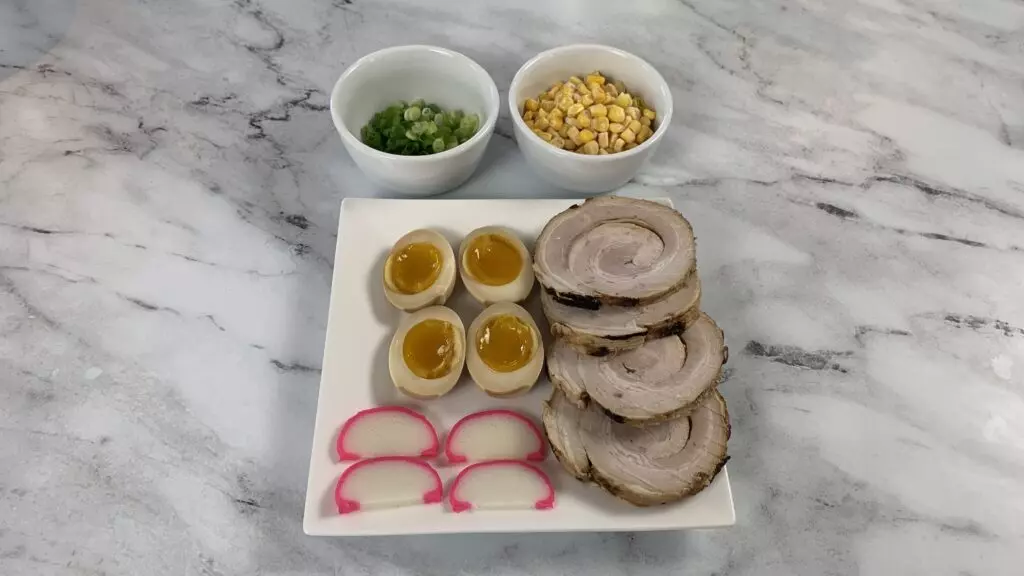
As with all components of ramen, chefs have freedom to make the dish their own based on the ingredients they use. I use fairly traditional toppings when making miso ramen. However, I do exclude ground pork, which is commonly used in this dish.
My miso ramen toppings include a slice of chashu pork, a ramen egg (ajitsuke tamago) cut into two halves with the yolk facing up, a slice of fish cake called kamaboko, a couple tablespoons of corn, and a sprinkle of scallions to garnish the chashu.
How to Make Miso Ramen
Preparing any type of ramen can be broken down to each of its five components. Below we will take you through each of these components step-by-step.
Prepare Broth
1. Heat chicken stock in a pot over low heat and bring to a simmer.

Prepare Miso Tare
1. Combine sugar, soy sauce, and sake into a bowl and stir until the sugar is dissolved into the mixture.

2. Once the sugar is dissolved, add miso paste and mix well.
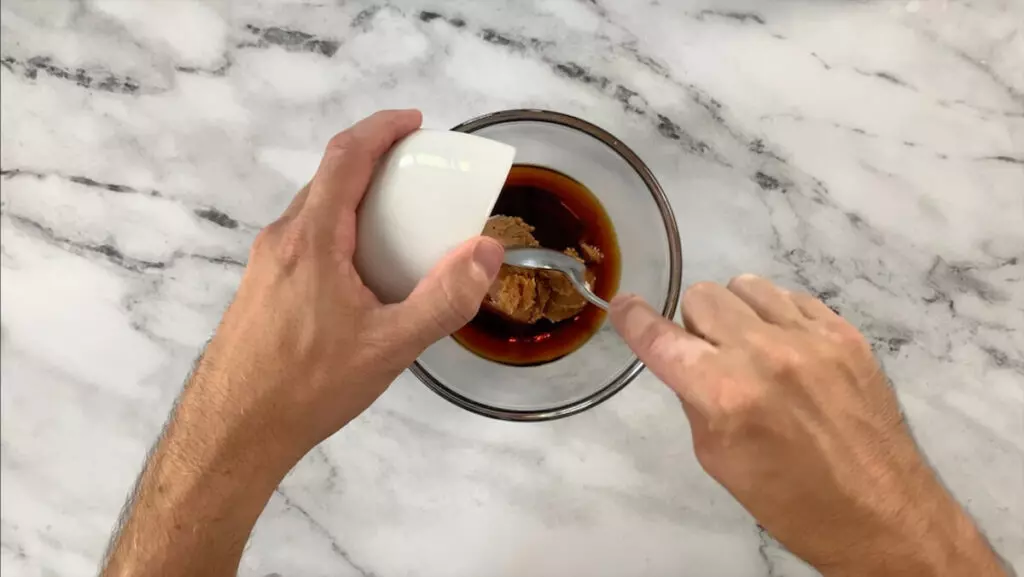
3. Once everything is mixed, your tare is ready. I usually add two tablespoons of this tare to my broth when making miso ramen. However, I would taste after adding one tablespoon and add more as needed.
Prepare Aromatic Oil
1. In a small sauce pan, heat the pork lard, sesame oil, and chili oil (la-yu) on medium-low heat until hot.
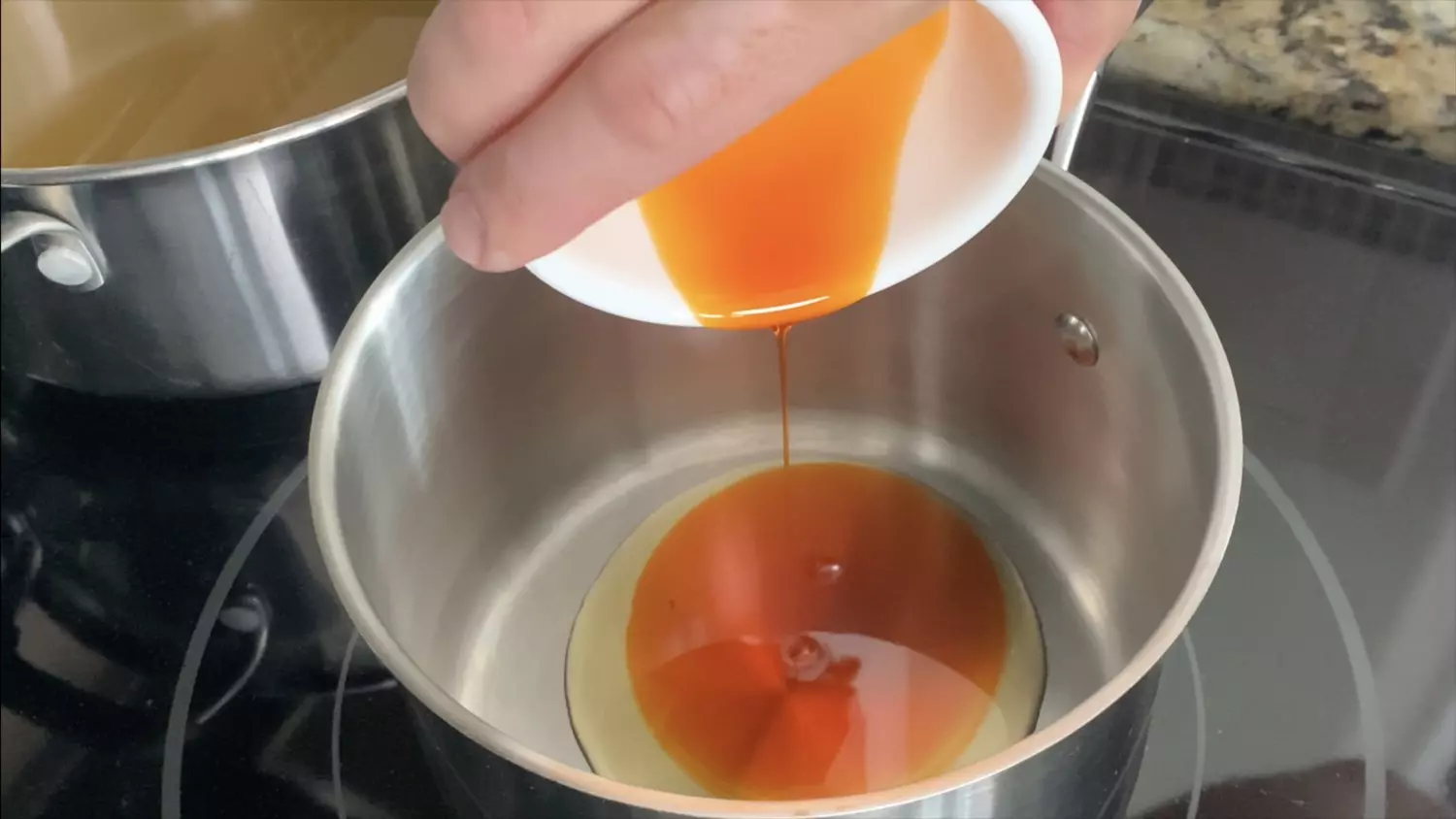
2. Add minced garlic and grated ginger to the oils and cook for 1-2 minutes, or until browned and releasing aromas. Make sure not to let the aromatics burn.
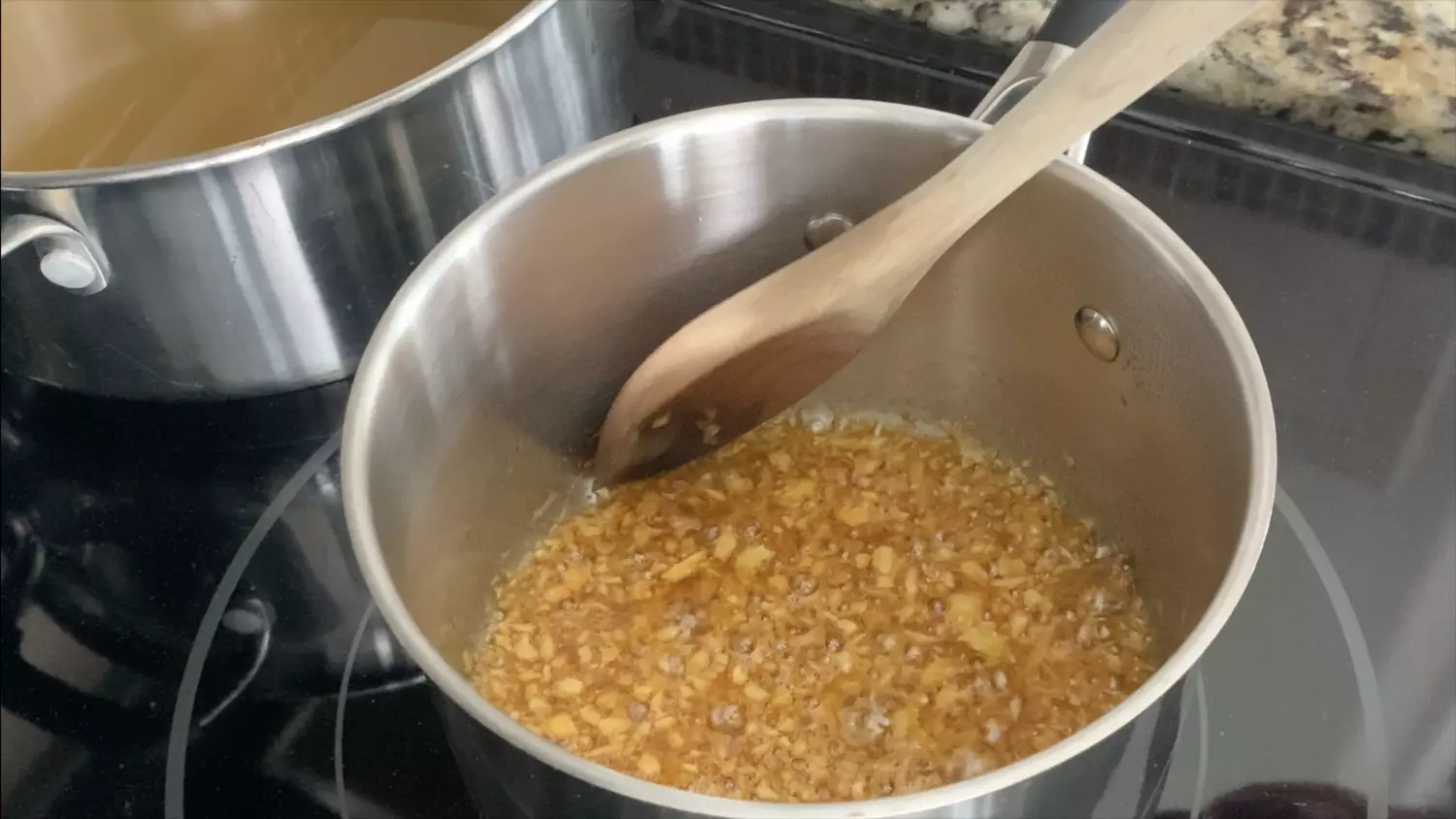
3. Once the aromatics are cooked, remove the oil mixture from the heat and let cool.
4. Once cool, strain oil into a small bowl.

Prepare the Toppings
1. Cut four slices about 1/4 inch thick off of the chashu pork. Heat each slice of chashu in a skillet with its cooking liquids.
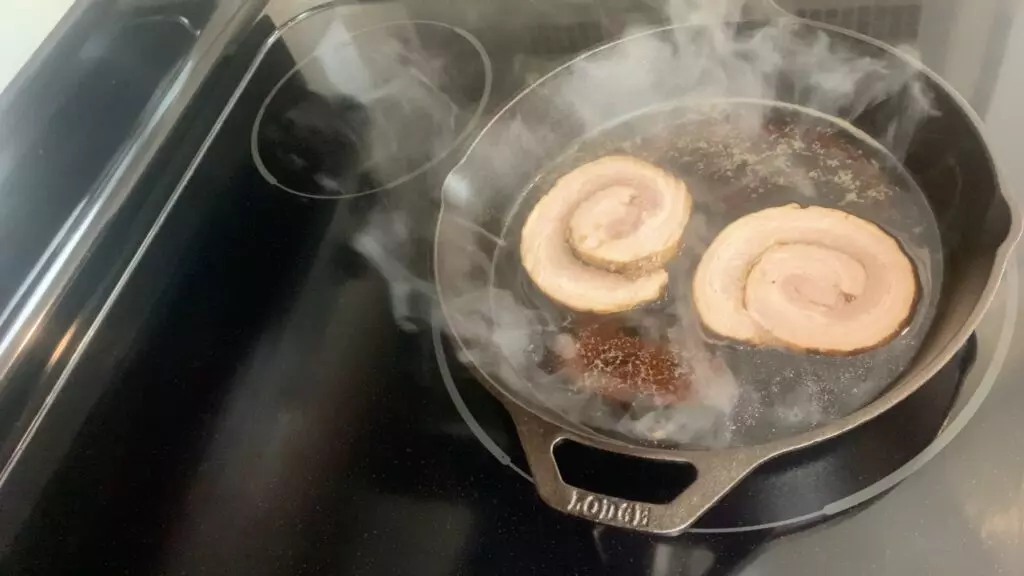
2. Cut ramen eggs in half. Also, cut the nori sheet into four strips.

3. Assemble remaining topping ingredients so they can be added to the soup quickly.

Cook Noodles and Assemble Soup
1. Follow the instructions on packaging to cook noodles in boiling water.
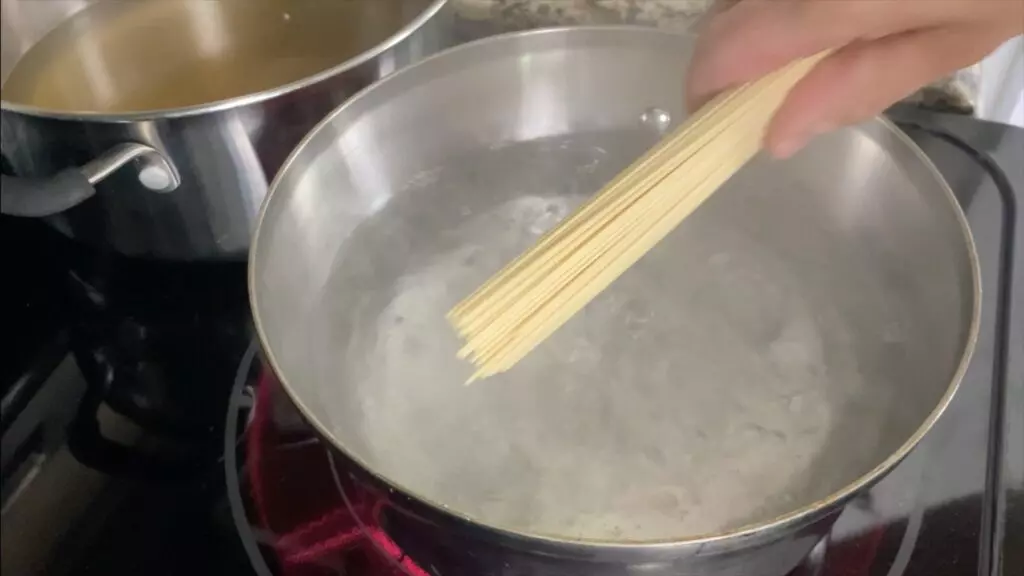
2. While the noodles are cooking, place 1 1/4 cups of the broth into a bowl. Add 2 tablespoons of the miso tare, and 1 tablespoon of the aromatic oil. Stir in tare as needed to make sure it is combined with the broth.
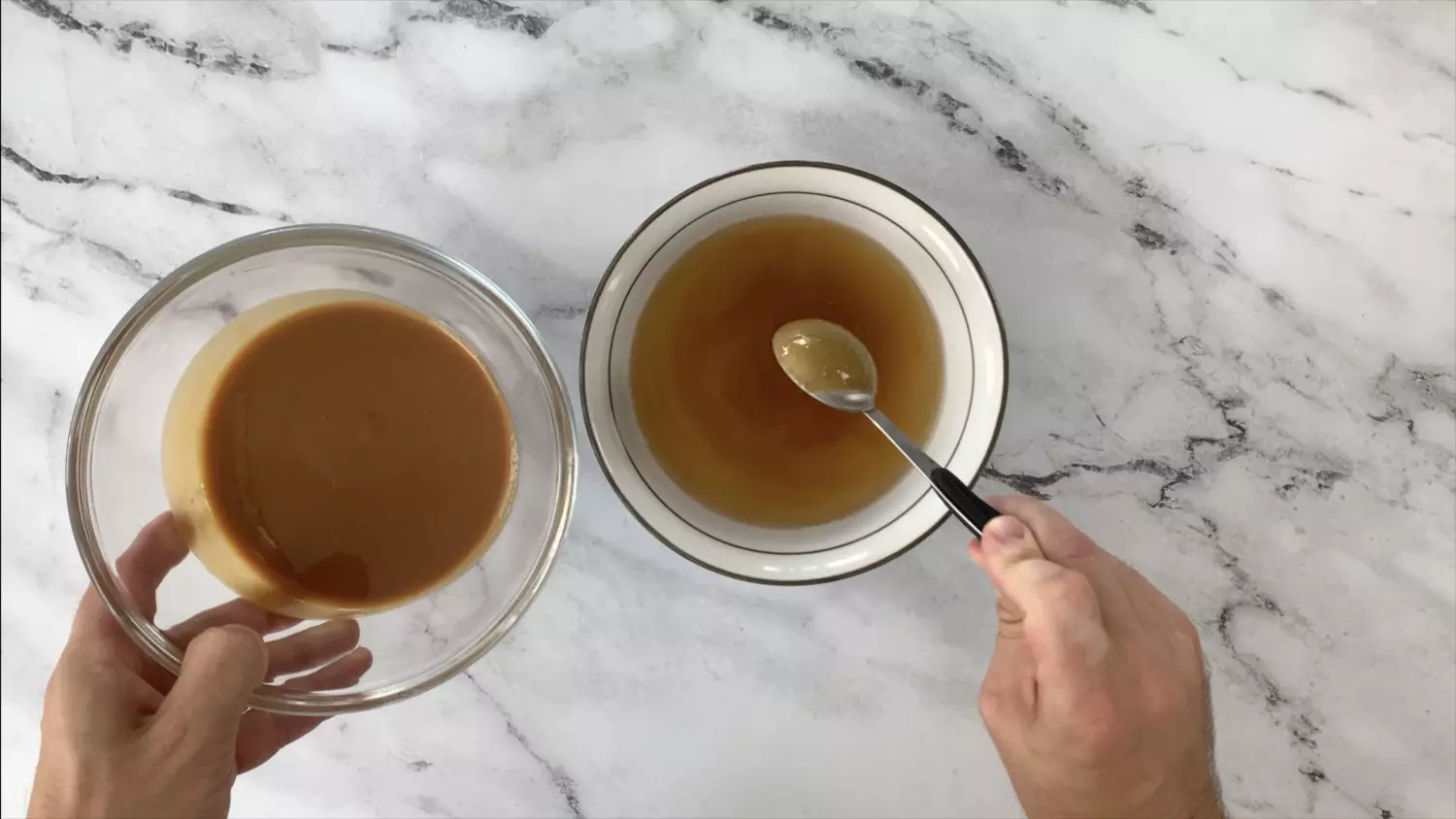
3. Once noodles are done cooking, strain thoroughly making sure to get rid of as much water from the noodles as possible. Once strained, add an individual portion of noodles to the bowl with the broth.
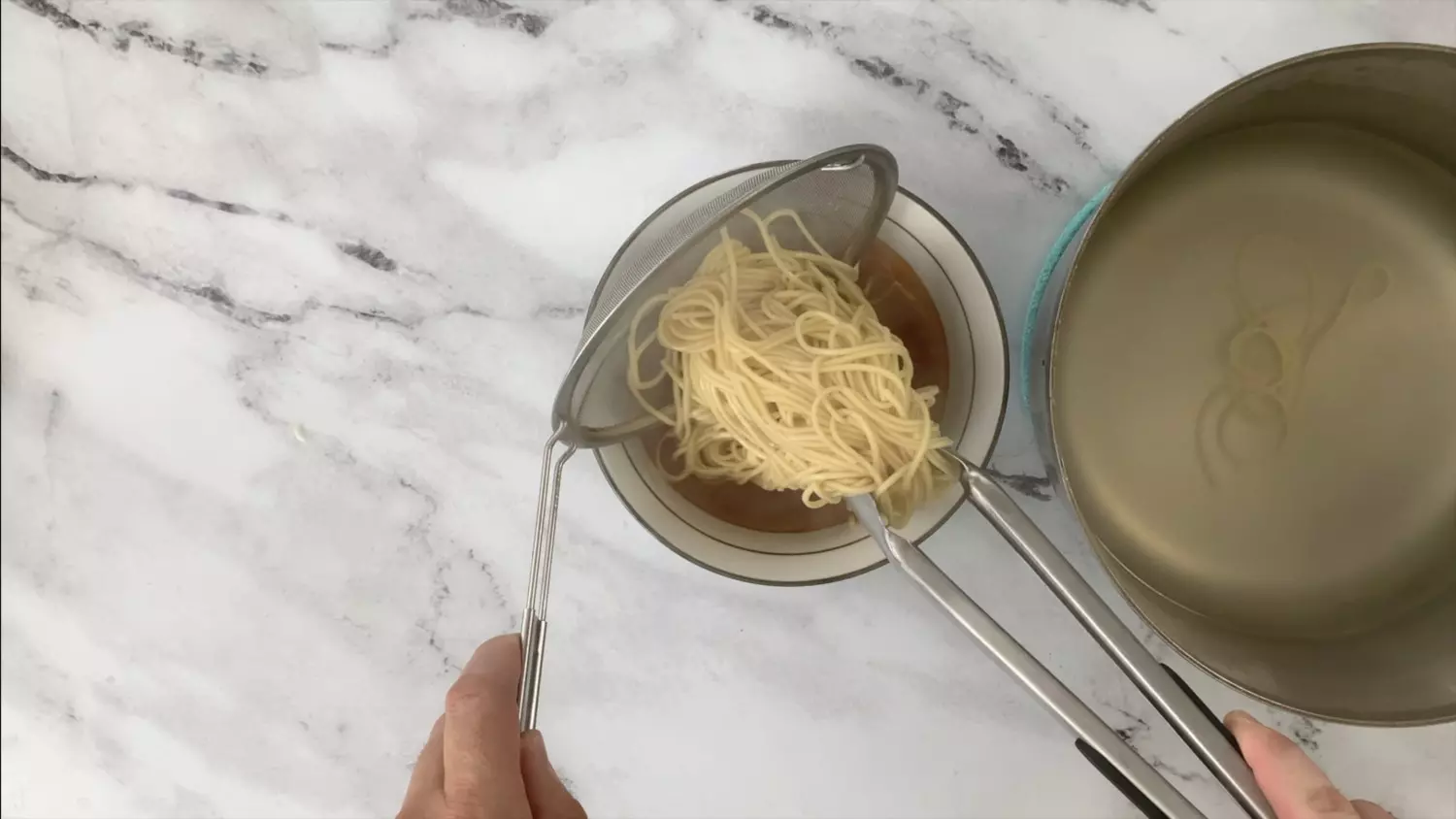
4. Add a chashu slice to the bowl of ramen.
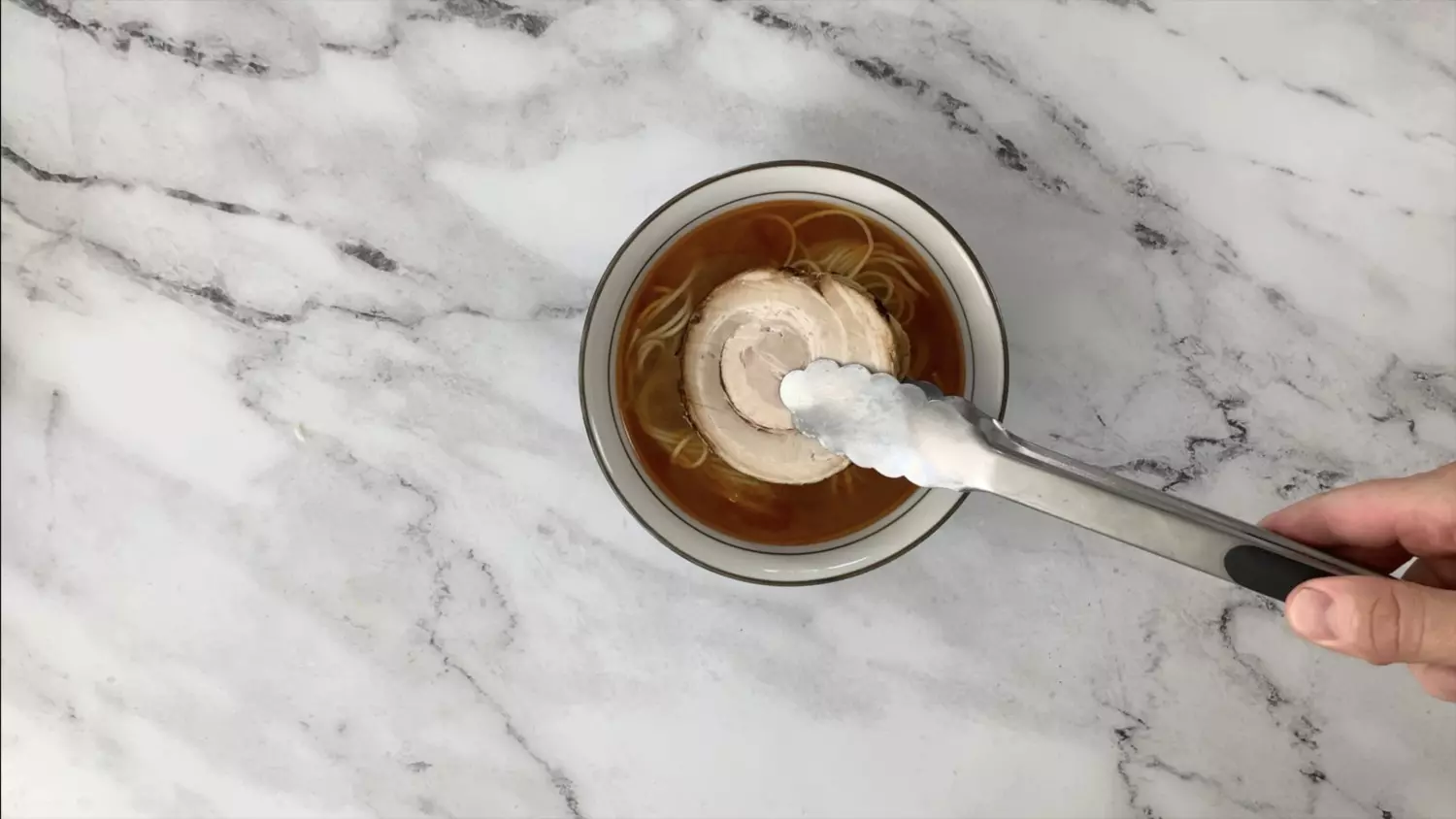
5. Place each half of the ramen egg in the broth with the yolk facing up.

6. Fold the strip of nori sheet in half and add to the bowl. Also, add a slice of narutomaki, 1/4 of the scallions, and two tablespoons of corn to the bowl.

7. Serve and enjoy!
Miso Ramen Recipe
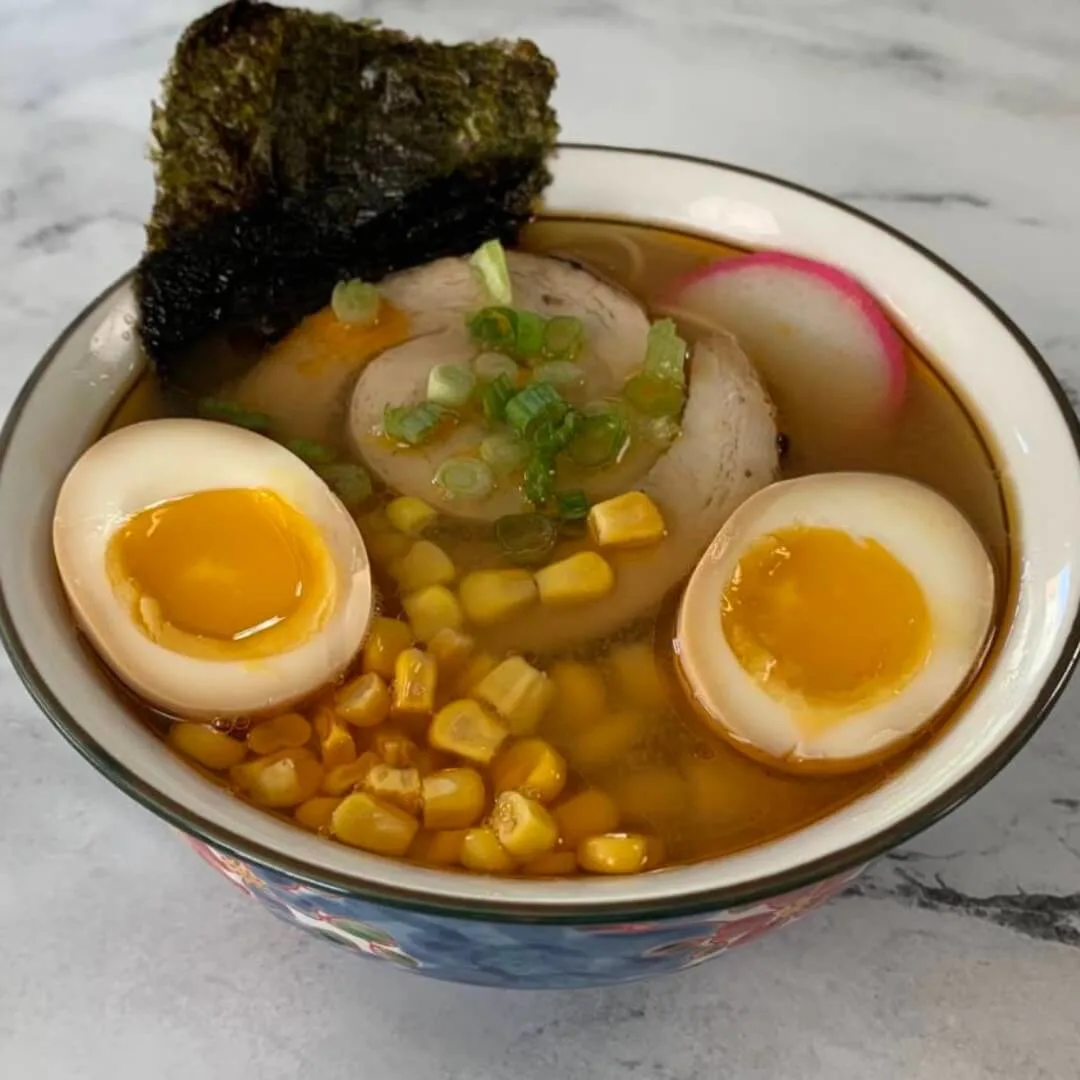
Miso Ramen Recipe
Equipment
- 1 Pot for broth
- 1 Sauce pot
- 1 Skillet
Ingredients
Broth
- 7 cups Chicken stock
Miso Tare
- 1/2 cup Red miso paste
- 1/2 cup Sake
- 1/4 cup Soy sauce
- 1 Tbsp. Sugar
Aromatic oil
- 2 Tbsp. Ginger freshly grated
- 6 cloves Garlic minced
- 1 Tbsp. Sesame oil
- 1/4 cup Pork lard
- 1 Tbsp. Chili oil (La-Yu)
Noodles, tare and toppings
- 4 Servings Ramen noodles 90 grams dry noodles
- 4 slices Chashu pork
- 4 slices Kamaboko (narutomaki is common type used)
- 4 Ramen eggs (Ajitsuke tamago)
- 1 Nori sheet cut into 8 even pieces
- 2 Scallions diced
- 1/2 cup corn
Instructions
Prepare broth
- Heat chicken stock in a pot over low heat and bring to a simmer.
Prepare miso tare
- Combine sugar, soy sauce, and sake into a bowl and stir until sugar is dissolved into the mixture.
- Once the sugar is dissolved, add the miso paste and mix well.
- Once everything is mixed, your tare is ready. I usually add two tablespoons of this tare to my broth when making miso ramen. However, I would taste after adding one tablespoon and add more as needed.
Prepare aromatic oil
- In a small sauce pan, heat the pork lard, chili oil (la-yu), and sesame oil on medium-low heat until hot.
- Once the oils are hot, add minced garlic and grated ginger and cook for 1-2 minutes or until browned and releasing aromas. Make sure not to let the aromatics burn.
- After the aromatics are done cooking, remove from the heat and let cool.
- Once cool, strain oil into small bowl.
Prepare the toppings
- Cut four slices about 1/4 inch thick off of the chashu pork. Heat each slice of chashu in a skillet with its cooking liquids.
- Cut ramen eggs in half. Also, cut nori sheet into four strips.
- Assemble remaining topping ingredients so they can be added to the soup quickly.
Cook noodles and assemble soup
- Follow the instructions on the noodles to cook noodles in boiling water.
- While the noodles are cooking, place 1 1/4 cups of the broth into a bowl. Add 2 tablespoons of the miso tare and 1 tablespoon of the aromatic oil. Stir in tare as needed to make sure it is combined with the broth.
- Once noodles are done cooking, strain thoroughly making sure to get rid of as much water from the noodles as possible. Once strained, add an individual portion of noodles to the bowl with the broth.
- Add a chashu slice to the bowl of ramen.
- Place each half of the ramen egg in the broth with the yolk facing up.
- Fold the half of the nori sheet in half and add to the bowl. Also, add a slice of narutomaki, 1/4 of the scallions, and two tablespoons of corn to the bowl.
- Serve and enjoy!
Video
Nutrition
Frequently Asked Questions
Is miso ramen healthy?
Generally, ramen is not the most healthy of dishes as the noodles can be fairly caloric and the broth can be high in sodium.
Is miso ramen gluten-free?
If you order miso ramen from a restaurant, it will not likely be gluten free as the tare and ramen eggs contain soy sauce and the noodles used will most likely contain gluten. However, you can make miso ramen gluten-free by using gluten-free soy sauce and gluten-free noodles.
Final Thoughts on Miso Ramen
Miso ramen is a hearty Japanese soup that’s hard to beat. Best of all, as long as you prepare the ramen eggs and chashu ahead of time, you can make miso ramen in a fairly short amount of time. I hope you have found this article helpful and the recipe delicious. Happy cooking!
Check out the below articles for more great recipes:
Authentic Tempura Dipping Sauce (Tentsuyu)
Ikura Sushi: What it is and How to Make it
Chirashi Bowl (Chirashizushi) Recipe
Also, for more great videos subscribe to our YouTube Channel.
